HOW TO AVOID UNEVEN MANE BRAIDS
How do I create perfectly even and identical hunter or dressage braids on all types of manes? Learn my simple strategy that works every time and the mane braiding mistakes that result in uneven mane braids. To help you get the turnout you deserve at the shows this year, I’m sharing another tip on braiding mistakes and how you can avoid them. This is the third post in my Mane Braiding Mistakes series. Here are the links to the other posts:
HOW TO AVOID A POORLY PREPARED MANE SO BRAIDING IS EASIER
HOW TO AVOID LOOSE MANE BRAIDS
BEST BRAIDING TIPS FROM NOTABLE EQUESTRIANS
Today I’m talking about hunter braids with an uneven bottom line and button braids that aren’t identical in size. Both of these braiding mistakes are usually due to one of the following things:
- The mane you’re braiding is uneven in length and you’re using it as your guide for braid length
- Your knots (or bands) at the bottom of each braid are at different heights
- The bottom knots of some of your braids have slipped
- You are working braid-to-braid
Here’s my simple strategy for creating even and identical hunter or button braids:
Mane Length: You’re probably tired of hearing me talk about how important mane preparation is to quality braiding but it really is critical for good, fast braiding. When you shorten the mane to an even length, you’ll create hunter braids with an even bottom line more easily or button braids that are identical in size. I recommend using an old pair of clipper blades to shorten a mane like I demonstrated this technique in my free video on Five Secrets for Perfect Mane Braids. If you haven’t seen the video, you can sign up for instant access to the video and my FREE library of mane braiding videos and resources here.
BEWARE of braiding videos boasting about leaving the mane really long. Often these demonstrations are done on a very easy mane type. If you left most manes that long it will take you more time to braid them and then you’ll have the frustration of dealing with the hair ends to a much greater extent than is shown on the soft, easy mane. Plus, if your horse rubs their braids it can be a disaster. I’m normally a positive, upbeat person but felt like I needed to share that with you since we’re Braiding BFFs.
Bottom Braid Knots: As you braid down the mane and tie off each braid, the knots you are creating will determine the bottom line of your hunter braids or the size of your button braids. If your bottom knots are at different heights (like a roller-coaster) from braid to braid, so will the bottom line or size of your finished braids. So your goal when braiding down is to make every braid end at the same point. You’ll know that you’re succeeding at this when the bottom braid knots (or bands) create a horizontal line across your horse’s neck as shown in this photo.
Create an Anchor Knot: When the knot at the bottom of the braid slips, it causes that braid to be slightly longer than the rest of your braids. This can ruin the even bottom line of your hunter braids or will cause a button braid to be a different size (larger than the others). So after you tie off your braids at the bottom, be sure to tie another single knot as shown in the photo below. This extra knot is your anchor because it ensures your bottom knot won’t slip. This will make it easier for you to tie down even or identical braids later.
Are You Working Braid-To-Braid? If you’re creating a single hunter or button braid and completing it (pulling it up and tying it down) you are working braid-to-braid. Approaching braiding in this manner puts you at a huge disadvantage for creating your best hunter or button braids. You need to have a neighboring braid to reference when you are braiding down the mane because otherwise you’re “guessing” at whether or not your braids are the same length. The result is that the bottom line of your hunter braids will be uneven or your button braids will not be identical in size.
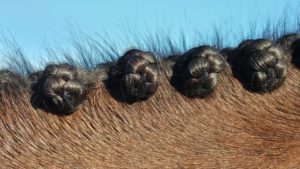 Braiding systematically (by braiding all of the mane down at once and then tying down all the braids) gives you the opportunity to plan the perfect outcome to your braids. So be sure to work systematically because it will give you the best braiding results.
Braiding systematically (by braiding all of the mane down at once and then tying down all the braids) gives you the opportunity to plan the perfect outcome to your braids. So be sure to work systematically because it will give you the best braiding results.
Pro Tip: Professional braiders only work braid-to-braid in very rare cases, such as when braiding a mane that has been pulled so short that it’s nearly unbraidable.
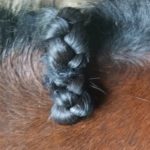 Hunter braids with an even bottom line and button braids that are identical is size are desirable because they make your horse look amazing in the show ring. I demonstrate some tips on how to braid down the mane in my free video on Five Secrets for Perfect Mane Braids. Click here to sign up for instant access to the video and my FREE library of mane braiding videos and resources.
Hunter braids with an even bottom line and button braids that are identical is size are desirable because they make your horse look amazing in the show ring. I demonstrate some tips on how to braid down the mane in my free video on Five Secrets for Perfect Mane Braids. Click here to sign up for instant access to the video and my FREE library of mane braiding videos and resources.
Knowing what NOT to do when braiding can go along way toward improving your braids and turnout. It also allows you to avoid the things that make mane braiding more difficult and time consuming.
ACTION STEP: The next time you’re at the barn, throw a few braids in your horse’s mane. Focus on the ending each braid at the same point so all your bottom knots are even. Be sure to tie an anchor knot too! When you do these two things well, your braids will be more even and identical.
What is the most difficult part of creating even or identical braids for you? Leave a comment so I can help you!
Get the knowledge to rock your turnout,
Mary Beth
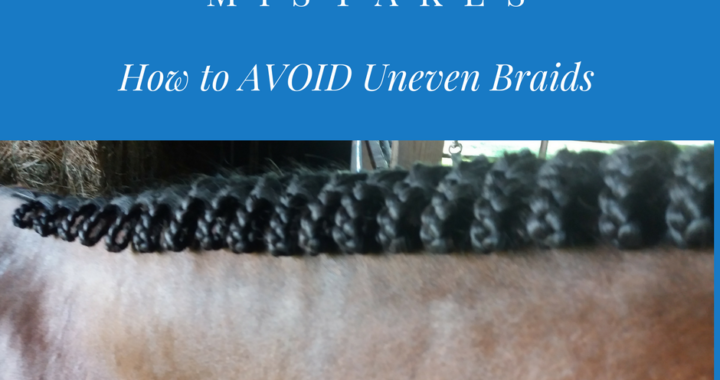
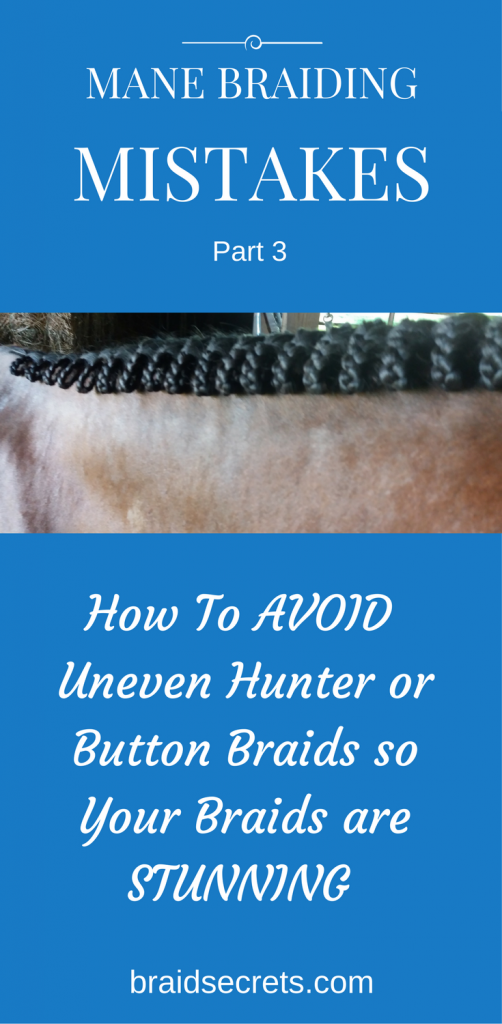
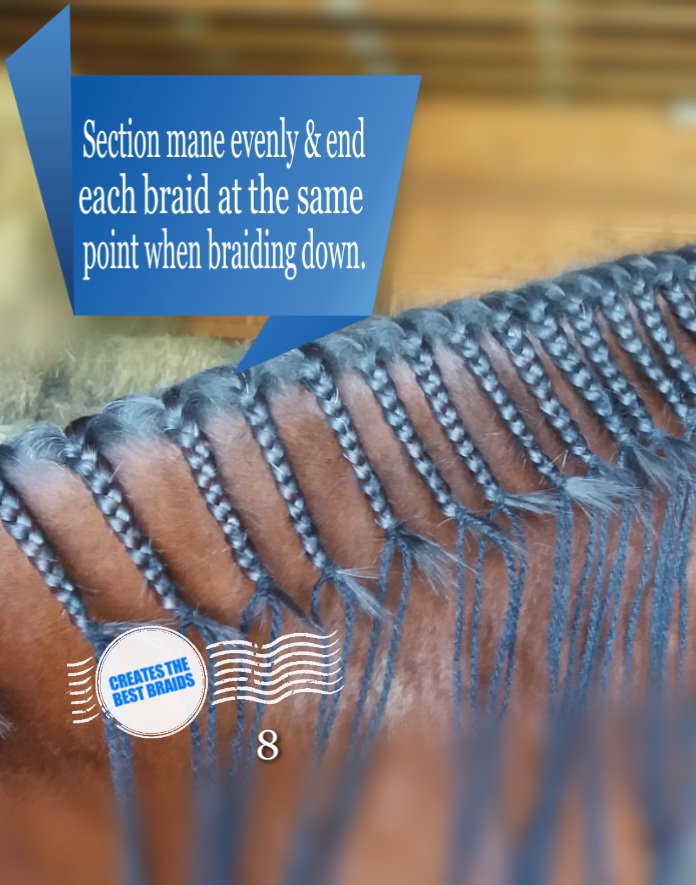
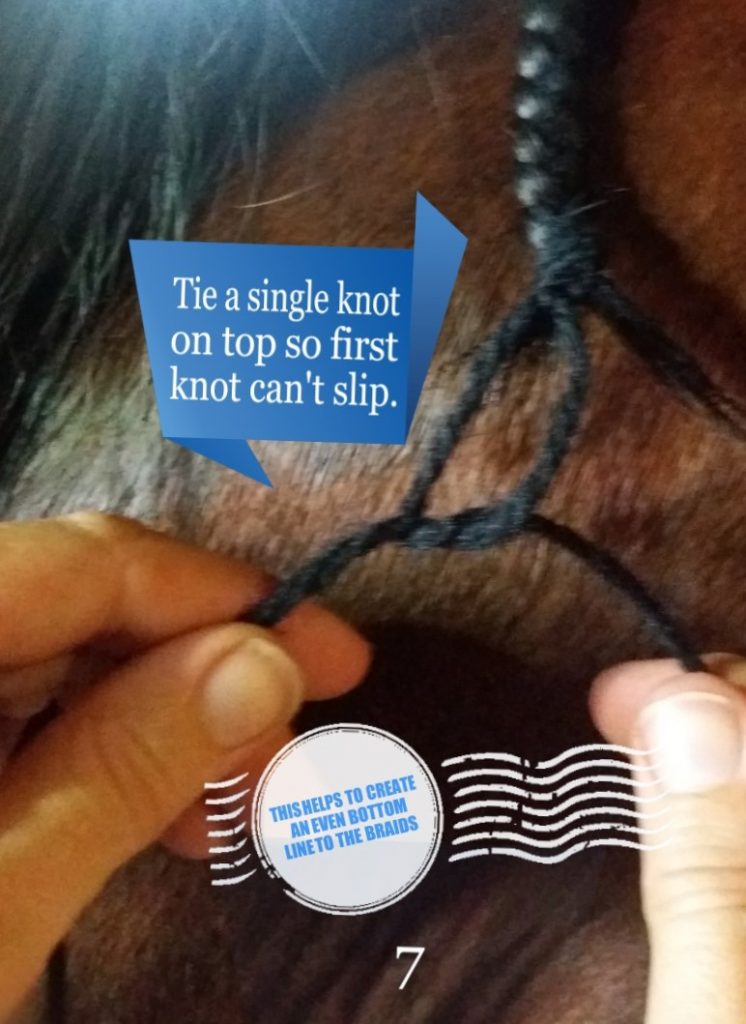
Pingback: MANE BRAIDING MISTAKES - HOW TO AVOID LOOSE BRAIDS - BRAID SECRETS
Pingback: MANE BRAIDING MISTAKES - POOR MANE PREPARATION - BRAID SECRETS
Pingback: THE BEST BRAIDING TIPS FROM NOTABLE EQUESTRIANS - BRAID SECRETS
Pingback: HOW TO AVOID LOOSE MANE BRAIDS SO YOUR BRAIDS ARE NEAT - BRAID SECRETS
I am trying to learn the Dutch Scallop style of braiding my dressage pony. Do you have a video or tips on that type of braiding. By the way your website is the best website I have found on braiding. Thank you!
Hi Laura, thanks for your compliment on my website. I hope you’re finding it helpful. I don’t currently have a video on creating Dutch style braids, but here are a couple of tips and a link to check out. Do yourself a huge favor and prepare your pony’s mane for braiding. The more coarse or thick the mane, the more important the mane preparation becomes to your braiding results (and ease). This means pulling thick areas of the mane so they’re manageable and evenly dense, and tapering the hair ends while shortening the mane to 5-6 inches long (for Dutch braids). I demonstrate these techniques in the Five Secrets for Perfect Mane Braids video in my Free Resource Library (you can sign up for instant access at the top of my homepage). The reason the mane preparation is so important is that it helps you create evenly spaced, identical braids across the neck in a timely manner. I like to section off a hands width (about 4 inches) for each Dutch braid. For each section part the hair on a diagonal to add to the scalloped look of your finished braids. There’s a photo of Dutch braids with an audio file at the bottom at https://braidsecrets.com/braid-critique/ where I’m providing feedback and advice on Dutch braids (to Amelia) and some advice on how to improve them that I think you will find helpful. Feel free to reply if you have further questions.
Pingback: BEST MANE BRAIDING TIPS FROM NOTABLE EQUESTRIANS - BRAID SECRETS
Youre so cool! I dont suppose Ive read anything like this before. So nice to find someone with some unique thoughts on this subject. realy thank you for beginning this up. this web site is one thing that’s needed on the internet, someone with a little bit originality. useful job for bringing one thing new to the web!